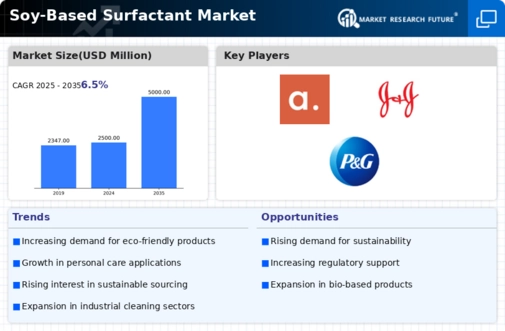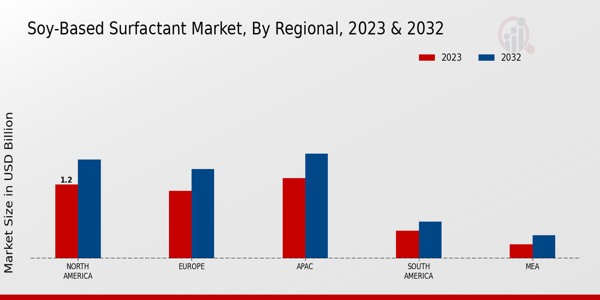Market Growth Projections
The Global Soy-Based Surfactant Market Industry is projected to experience substantial growth over the next decade. With a market value expected to reach 2500 USD Million in 2024 and potentially doubling to 5000 USD Million by 2035, the industry is on a robust upward trajectory. This growth is underpinned by a compound annual growth rate of 6.5% from 2025 to 2035, indicating a strong demand for soy-based surfactants across various sectors. The increasing adoption of sustainable practices and the versatility of these surfactants are likely to contribute to this positive outlook.
Innovations in Product Development
Innovations in product development are propelling the Global Soy-Based Surfactant Market Industry forward. Companies are investing in research and development to create new formulations that enhance the performance of soy-based surfactants. This includes improving their efficiency in cleaning applications and expanding their use in various industries. For instance, advancements in processing technologies have led to the creation of more effective soy-based surfactants that can compete with traditional petrochemical-based options. Such innovations not only meet consumer demands for performance but also align with sustainability goals, thereby driving market growth.
Growing Demand for Eco-Friendly Products
The increasing consumer preference for sustainable and eco-friendly products is a primary driver of the Global Soy-Based Surfactant Market Industry. As environmental awareness rises, manufacturers are shifting towards natural ingredients, including soy-based surfactants, which are biodegradable and derived from renewable resources. This trend is evident in various sectors, including personal care and household cleaning products, where companies are reformulating their products to meet consumer expectations. The market is projected to reach 2500 USD Million in 2024, reflecting a significant shift towards greener alternatives in product formulations.
Versatility Across Multiple Applications
The versatility of soy-based surfactants across various applications is a significant driver for the Global Soy-Based Surfactant Market Industry. These surfactants are utilized in diverse sectors, including agriculture, personal care, and industrial cleaning. Their ability to function effectively in different formulations enhances their appeal to manufacturers looking for multifunctional ingredients. For example, in the agricultural sector, soy-based surfactants are employed as adjuvants to improve pesticide efficacy. This broad applicability not only supports market expansion but also encourages innovation in product development, further solidifying the market's growth trajectory.
Rising Health Consciousness Among Consumers
The growing health consciousness among consumers is influencing the Global Soy-Based Surfactant Market Industry. As individuals become more aware of the potential health impacts of synthetic chemicals, there is a marked shift towards natural and organic products. Soy-based surfactants, known for their mildness and safety, are increasingly favored in personal care products such as shampoos and lotions. This trend is particularly pronounced in regions with stringent health regulations, where consumers demand transparency in ingredient sourcing. Consequently, the market is anticipated to reach 5000 USD Million by 2035, driven by this heightened focus on health and wellness.
Regulatory Support for Biodegradable Surfactants
Government regulations promoting the use of biodegradable surfactants are bolstering the Global Soy-Based Surfactant Market Industry. Many countries are implementing stricter environmental regulations that favor the adoption of sustainable ingredients in manufacturing processes. For instance, the European Union has established guidelines that encourage the use of bio-based products, which include soy-based surfactants. This regulatory environment not only supports market growth but also incentivizes companies to innovate and invest in sustainable practices. As a result, the market is expected to experience a compound annual growth rate of 6.5% from 2025 to 2035.


 Source: Primary Research, Secondary Research, MRFR Database and Analyst Review
Source: Primary Research, Secondary Research, MRFR Database and Analyst Review

